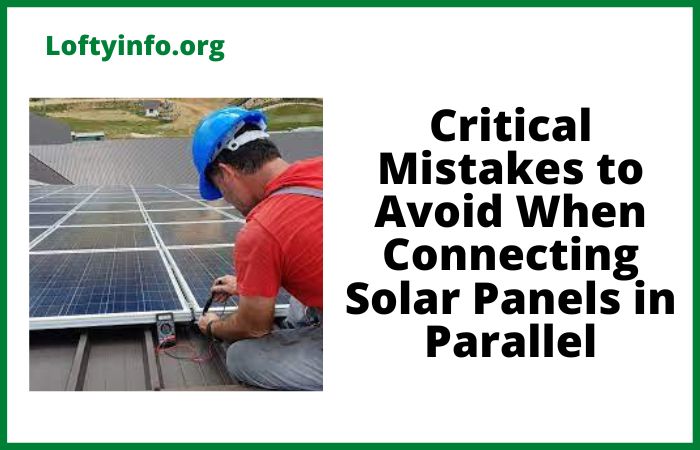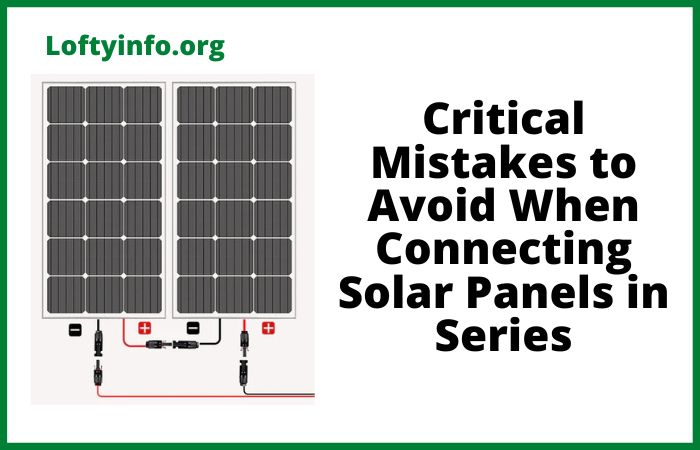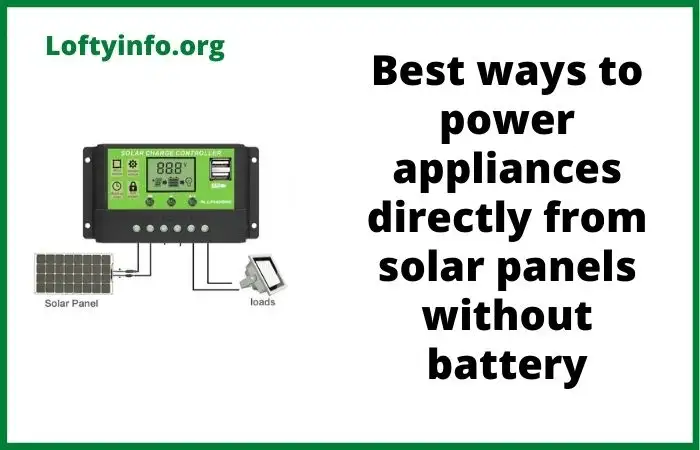Critical Mistakes to Avoid When Connecting Solar Panels in Parallel
Connecting solar panels in parallel is a popular method to increase current output while maintaining the same voltage.
Improper parallel connections can lead to significant power losses, safety hazards and reduced system efficiency.
Understanding these common mistakes can save you thousands of dollars and ensure optimal performance from your solar installation.
Mistakes to Avoid When Connecting Solar Panels in Parallel
1) Mixing Different Solar Panel Specifications
One of the most detrimental mistakes when wiring solar panels in parallel is combining panels with different electrical characteristics.
When panels with varying voltage ratings, current outputs, or power ratings are connected in parallel, the system performance drops to the level of the weakest panel.
For example, connecting a 300W panel producing 8.5A with a 250W panel producing 7.2A will cause the higher-performing panel to operate below its capacity.
The voltage across all parallel-connected panels equalizes to the lowest common voltage, while current differences can create reverse current flow.
This mismatch not only reduces overall system efficiency but can also cause hot spots and premature panel degradation.
Always ensure that parallel-connected panels have identical voltage ratings, similar current outputs, and preferably come from the same manufacturer and model line.
If you must use different panels, group similar specifications together on separate parallel strings rather than mixing them randomly.
2) Inadequate Wire Sizing and Current Capacity
Undersized wiring is a dangerous oversight that many DIY installers make when connecting solar panels in parallel.
As you add more panels in parallel, the total current increases proportionally, requiring thicker gauge wires to handle the higher amperage safely.
Using wire that’s too thin for the combined current load creates several problems.
The wire will experience voltage drop, reducing the power delivered to your charge controller or inverter.
More critically, undersized wires generate excessive heat, creating fire hazards and potentially melting wire insulation.
Calculate the total current by adding up the short-circuit current ratings of all parallel panels, then multiply by 1.25 as required by electrical codes.
Use this value to determine the appropriate wire gauge from standard ampacity tables.
For instance, if four 9Amps panels are connected in parallel, you’ll need wire rated for at least 45A (4 × 9A × 1.25). This typically requires 8 AWG wire for most installations.
3) Improper Fuse and Circuit Protection
Failing to install adequate overcurrent protection in parallel solar arrays is both a code violation and a serious safety risk.
Each parallel string should have its own fuse or circuit breaker rated slightly above the panel’s maximum current output but well below the wire’s ampacity rating.
The primary purpose of these fuses is to protect against reverse current flow when one panel or string experiences partial shading or failure.
Without proper protection, current from healthy panels can flow backward through the compromised string, potentially causing overheating and fire.
Install fuses rated at approximately 1.5 times the panel’s rated current.
For an 8Amps panel, use a 12Amps or 15Amps fuse.
These fuses should be housed in a weatherproof combiner box with proper labeling. Additionally, install a main breaker sized for the total array current to provide system-wide protection.
4) Neglecting Grounding and Bonding Requirements
Electrical grounding in parallel solar installations is often misunderstood or improperly implemented.
Many installers focus solely on the DC connections while neglecting proper equipment grounding and system bonding, creating potential shock hazards and code violations.
Every solar panel frame must be bonded to the equipment grounding conductor using approved grounding lugs and conductors.
The grounding electrode conductor should be sized according to the system’s current capacity, not just individual panel requirements.
In parallel systems with higher currents, this often means using larger grounding conductors than series installations.
Establish a single point grounding system where all equipment grounds connect to avoid ground loops.
The grounding electrode should be properly installed with adequate electrode-to-earth contact and all connections should use corrosion-resistant materials suitable for the installation environment.
5) Creating Voltage Imbalances Through Poor Layout
Physical panel placement and wiring layout significantly impact parallel system performance. Connecting panels that experience different amounts of sunlight, shading patterns or ambient temperatures in the same parallel string creates voltage imbalances that reduce overall system efficiency.
Panels facing different directions or installed at varying tilt angles will produce different voltages throughout the day.
When connected in parallel, these voltage differences cause current to flow between panels rather than toward the load, wasting energy and potentially damaging equipment.
Design your parallel strings so that panels in each group experience similar environmental conditions.
Group panels by orientation, tilt angle and shading characteristics.
If your installation spans different roof sections or ground areas, create separate parallel strings for each distinct zone rather than connecting all panels together.
6) Insufficient Monitoring and Troubleshooting Capabilities
Installing parallel solar arrays without adequate monitoring capabilities makes it nearly impossible to identify performance issues or component failures.
Unlike series connections where a single panel failure affects the entire string, parallel systems can mask individual panel problems while continuing to operate.
A failed or underperforming panel in a parallel string may go unnoticed for months while reducing overall system output.
Without string-level monitoring, identifying which specific panel or connection has failed becomes a time-consuming troubleshooting process.
Implement monitoring at both the string and system level.
String-level monitoring allows you to compare the performance of parallel groups and quickly identify underperforming sections.
Individual panel monitoring, while more expensive, provides the most detailed performance data and fastest fault identification.
At minimum, install DC ammeters on each parallel string to monitor current output and identify imbalances.
Optimizing Your Parallel Solar Installation
Successfully avoiding these common mistakes requires careful planning, proper component selection, and adherence to electrical codes.
Start by designing your system with matched components, properly sized conductors, and appropriate safety equipment.
Consider consulting with certified solar installers for complex installations or when local codes require professional oversight.
Regular maintenance and performance monitoring will help identify issues before they become costly problems.
Clean connections, verify proper grounding and monitor system performance metrics to ensure your parallel solar array continues operating at peak efficiency for decades to come.
Remember that while parallel connections offer advantages in certain situations, they also introduce complexity that requires careful attention to detail.
Taking time to avoid these mistakes during installation will result in a safer, more efficient and longer-lasting solar energy system.






